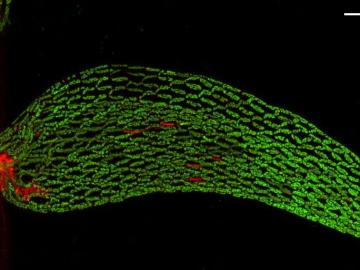
Filter News
Area of Research
- Advanced Manufacturing (7)
- Biology and Environment (33)
- Computational Engineering (2)
- Computer Science (7)
- Electricity and Smart Grid (2)
- Energy Science (65)
- Functional Materials for Energy (1)
- Fusion and Fission (3)
- Fusion Energy (2)
- Isotopes (2)
- Materials (45)
- Materials Characterization (1)
- Materials for Computing (10)
- Materials Under Extremes (1)
- Mathematics (1)
- National Security (7)
- Neutron Science (13)
- Nuclear Science and Technology (2)
- Quantum information Science (4)
- Sensors and Controls (1)
- Supercomputing (18)
- Transportation Systems (2)
News Type
News Topics
- (-) Composites (16)
- (-) Cybersecurity (9)
- (-) Environment (67)
- (-) Grid (28)
- (-) Machine Learning (19)
- (-) Materials Science (54)
- (-) Polymers (15)
- (-) Quantum Science (18)
- 3-D Printing/Advanced Manufacturing (57)
- Advanced Reactors (18)
- Artificial Intelligence (33)
- Big Data (26)
- Bioenergy (26)
- Biology (31)
- Biomedical (18)
- Biotechnology (6)
- Buildings (31)
- Chemical Sciences (31)
- Clean Water (14)
- Computer Science (70)
- Coronavirus (15)
- Critical Materials (13)
- Emergency (2)
- Energy Storage (50)
- Exascale Computing (11)
- Fossil Energy (1)
- Frontier (10)
- Fusion (19)
- High-Performance Computing (33)
- Hydropower (6)
- Irradiation (3)
- Isotopes (15)
- ITER (5)
- Materials (70)
- Mathematics (3)
- Mercury (3)
- Microscopy (21)
- Molten Salt (6)
- Nanotechnology (25)
- National Security (13)
- Neutron Science (42)
- Nuclear Energy (36)
- Partnerships (11)
- Physics (11)
- Quantum Computing (9)
- Security (4)
- Simulation (16)
- Software (1)
- Space Exploration (11)
- Statistics (1)
- Summit (11)
- Transportation (52)
Media Contacts

OAK RIDGE, Tenn., Feb. 12, 2020 -- Michael Brady, a researcher at the Department of Energy’s Oak Ridge National Laboratory, has been named fellow of the National Association of Corrosion Engineers, or NACE International.

Researchers at ORNL demonstrated that sodium-ion batteries can serve as a low-cost, high performance substitute for rechargeable lithium-ion batteries commonly used in robotics, power tools, and grid-scale energy storage.

A novel approach developed by scientists at ORNL can scan massive datasets of large-scale satellite images to more accurately map infrastructure – such as buildings and roads – in hours versus days.

Rigoberto “Gobet” Advincula has been named Governor’s Chair of Advanced and Nanostructured Materials at Oak Ridge National Laboratory and the University of Tennessee.

To better determine the potential energy cost savings among connected homes, researchers at Oak Ridge National Laboratory developed a computer simulation to more accurately compare energy use on similar weather days.

Researchers at Oak Ridge National Laboratory demonstrated that an additively manufactured polymer layer, when applied to carbon fiber reinforced plastic, or CFRP, can serve as an effective protector against aircraft lightning strikes.

A team of scientists found that critical interactions between microbes and peat moss break down under warming temperatures, impacting moss health and ultimately carbon stored in soil.

Researchers at the Department of Energy’s Oak Ridge National Laboratory have received five 2019 R&D 100 Awards, increasing the lab’s total to 221 since the award’s inception in 1963.

Researchers at Oak Ridge National Laboratory proved that a certain class of ionic liquids, when mixed with commercially available oils, can make gears run more efficiently with less noise and better durability.

A team including Oak Ridge National Laboratory and University of Tennessee researchers demonstrated a novel 3D printing approach called Z-pinning that can increase the material’s strength and toughness by more than three and a half times compared to conventional additive manufacturing processes.


